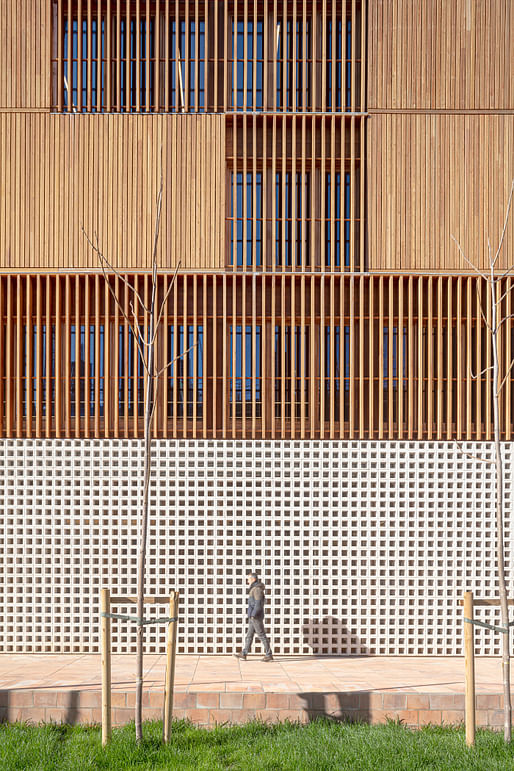
A new multi-use complex made nearly entirely of wood has been introduced to Barcelona’s Trinitat Vella district.
Called the Center for Community Life, the new public building will form part of a community facility hub for the districts of San Andreu and Nou Barris set to be built in the coming years. It will house various social services and bodies, including a Women’s Information and Attention Point, along with community housing and homes for young people and the elderly. The facility is the work of architects Manuel Sánchez-Villanueva and Carol Beuter of Haz Arquitectura, a studio with expertise in the construction of public and private spaces in the health, cultural, and social sectors, as well as offices and sports amenities.
Because this is the first building in the future complex, the firm wanted to avoid creating a major contrast with the upcoming projects. Therefore, they opted for a simple, abstract outer design that opens up to a future plaza that will link the various facilities.

Image Copyright Adrià Goula
Two covered courtyards located on each side of the circulation shaft ensure light and ventilation throughout the building. Inside, the ground floor houses the reception, the canteen, and a large entrance that acts as a foyer for the assembly hall, which can also host exhibitions and other activities. The first floor will host the Women’s Information and Attention Point and other social services. Across the rest of the floors, offices and spaces for local bodies and associations are positioned around a central shaft.
The architects decided to use wood as the primary material in order to add a feeling of warmth and comfort to the volume, contrasting the harsh surroundings of the city’s outskirts. They also chose wood because of its ability to combat the environmental impact of the building’s carbon footprint, as it enables the structure to absorb carbon dioxide throughout its life.
Image Copyright José Hevia
A completely dry construction method was used. A metal framework of girders and pillars was erected that works in collaboration with a load-bearing system of radiata pine cross-laminated wood panels and ceilings that brace and give stability to the whole. The interior claddings are limited to areas of plywood skirting to enable the passage of electrical and data connections. Otherwise, the interiors are the bare CLT structure and the metal framework.

Image Copyright José Hevia
The center employs passive features, addressing all heating and cooling needs. Its ventilation system harnesses the inertia of the ground with clean air tubes placed into the cutting in the hillside. Originating from the ground, the air in the tubes is heated and released into the two covered courtyards that function as large conductors. The renewed air is cool in the summer and warm in the winter. All of the rooms capture the air from the courtyards and treat it with a fan coil unit to slightly raise or lower its temperature and humidity as needed.
All of the walls and doors are designed in a way that returns the air through central chimneys that direct it to the machine room on the roof. Air is blown directly onto the machines, generating a local atmosphere that is warmer or cooler than the outside environment, which allows them to operate with less effort and less electricity consumption. Finally, the roof generates 60,000W of electrical power a year by means of photovoltaic panels, making consumption close to zero.
No Comments
Block this user
Are you sure you want to block this user and hide all related comments throughout the site?
Archinect
This is your first comment on Archinect. Your comment will be visible once approved.